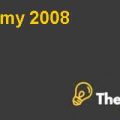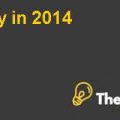
AN INDUSTRY IN DECLINE
Greeting card industry was faced massive changes as it had attained maturity and was now in decline. Overall greeting card sales had been contracting in the U.S. for some years and negative growth was expected in the next five years to 2015 (Exhibit 4).
Hallmark was the largest card company in the U.S. that was privately owned by the Hall family with $4 billion of revenues. The organization had expanded its operations in more than hundred nations and thus it was well-diversified geographically. Overall, the U.S. card industry was contracting with 9% reduction in last six years and the trend was expected to continue with a minimum of 4% decline over next 4 years and 16% in a worst case scenario. Major cause and diver of this decline in demand was changing social interaction norms and advent of alternative forms of communications through social networking and digital imaging. Increase in use of these alternatives by the populace to express their love and keep in touch with their close ones was reducing the need to send paper based greeting cards.
As a result, greeting card companies were increasingly moving to electronic card distribution through internet websites but the declining trend did not change much. Some companies were diversifying their business away from pure greeting card business to other related product categories. In this regard AG was trying to expand its sales through discount retail stores such as the dollar-store and was increasing investment in new technologies to enhance its presence in digital e-card segment through internet websites.
IMPACT OF MARKET CONDITIONS ON AG
Although there was potential for growth in digital e-cards segment for AG, overall revenues were mature with low growth rate that showed the company was at the maturity stage. Having reached maturity stage of its life cycle that was coupled with the industry in decline, market confidence at AG’s future prospects had collapsed. Though market conditions played a role in recent drop in AG’s share price, an argument can be made that much of the company’s troubles were due to external market factors that were mostly beyond its control, a quick look at data in Exhibit 6 show that even with unfavorable market conditions, other companies were far better with higher multiples than AG. This meant external factors and market conditions were unlikely to be the only reason for low confidence in AG.
There must be other unique factors that were reflected in AG’s share price. Perhaps, other companies had better strategies in place with greater earning potential in future than AG. Some of the potential internal factors are as follows:
PRODUCT DIVERSIFICATION
AG’s competitors appear to have better diversified products that are less likely to be as severely impacted by a decline in the demand of greeting cards (Exhibit 6 continued). Heavy reliance on greeting card revenues by AG is likely to one of the main reasons for its low investor confidence. An analysis at Exhibit G show that company relied on nearly 75% on every-day seasonal card sales for its revenues that reinforces the notion that company’s offerings were not adequately diversified.
DECREASE IN MARGINS
Another major factor was a decrease in profitability margins. With the company moving in e-card segment and low price discount store based card distribution, it was unlikely that even if the firm succeeded in sustaining its growth of 2011, its profitability would be severely impacted by reduction in profit margins. This situation was likely to worsen in the short term with an increase in marketing expenditure to accompany AG’s move in new distribution channels.
VALUATIONS
By 2012 New Year’s Eve, AG Shares were trading at $12.51 per share that represented PE ratio of 6x and EV to EBITDA multiple of 3.5x. Going forward, there were two sets of analyst expectations for the company. Standard and Poor’s anticipated 2.5% sales increase to $1.73 billion through discount store card distribution and international sales. In the short term, squeeze on margins was expected because of marketing expenses to spur demand and plans to move headquarter building. S&P expected channel migration to result in permanent reduction in margins. Value Line analyst held more optimistic view expecting performance to strengthen in digital space, enhanced product diversification and strong retail partnerships...............
This is just a sample partial case solution. Please place the order on the website to order your own originally done case solution.
The solution will also come with a separate excel file with calculations.













